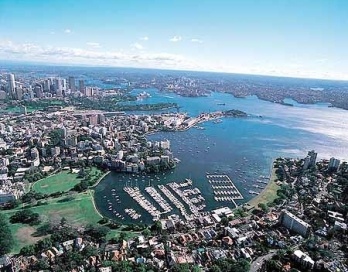
Baía em Sidney, próxima do Centro de Negócios
Foto: Patrick Bingham Hall [fonte: Archis Agosto 2000]
Ana Paula Baltazar: Archis has always been a "different" architectural publication: first for its format and graphic design, and mainly through its content. I'd like you to comment on the reasons and effects of the change of publisher, such as the celebrative character of NAi publishers in contrast to the critical view expressed by Archis, and the attempt to provide a more interactive magazine with the new format published by Artimo. How do you see the impact of the new format for the public (usual buyers and new buyers) and what are the main differences of approach from NAi to Artimo with regards to both form and content?
Most of architectural publications usually claim to have a critical view. It is interesting the approach of NAi towards a celebration of the Dutch architecture, and it seems to "sell" very well worldwide (I have seen their year books everywhere). How do you see the tendencies of architectural journalism in general, and specifically how do you see Archis in this context? How do you approach the specialisation of issues in architecture without loosing touch with the general approach needed to keep the social in sight?
Ole Bouman: Archis has always been a reflexive magazine. However, it had to deal with two factors that were increasingly hostile to this tradition. First of all, as a product on the market, it was positioned by its publisher from a very specific niche-oriented angle. Elsevier wanted to produce a title for the Dutch designer's community, and derived its whole policy in terms of marketing from this idea. Meanwhile, the publisher had a growing urge to increase profit margins. Both tendencies were bad for a title that was determined to explore architecture as it could be, instead of publishing how it is.
The other factor has to do with the culture in which architecture is reduced to the production of a few stars. It would be very easy to capitalize on the fame and popularity of Dutch architecture, by emphasizing endlessly the work of the national top 10. However, we feel it our public responsibility to anticipate future potentials of architecture in terms of mandate and strategies, in order to help the discipline continue to flourish. This ambition is tricky and sometimes badly understood because it always is about asking new questions, testing reputations and defining new territories. Nothing is taken for granted.
By becoming independent and with Artimo as new publisher, Archis could renew the aforementioned ambitions and become more clear about them. We started a quest for a magazine that wishes to stimulate and to test the mental space of its readers, by offering interactive 'moments' in the magazine. Next year this policy is further worked out by the introduction of a web environment that completes the triangle of mental, physical and network space. We have high hopes that this ambition will be a success, being recognized by the most adventurous people engaged with architecture throughout the world. Nevertheless, since this is always an experimental work, we can never aspire to enter a mass market.

Peter Greenaway, Grande Terp, Dorkwerd (próximo a Groningen)
[fonte: Archis Maio 2001]



